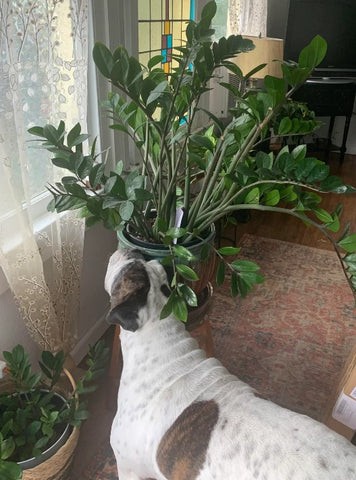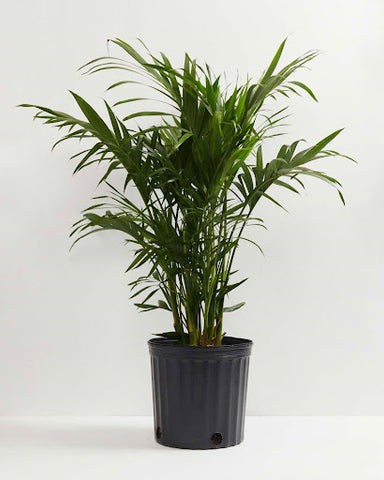Are Zz Plants Pet Safe? Yes, but with caution! ZZ plants (Zamioculcas zamiifolia) are mildly toxic to pets due to calcium oxalate crystals. At PETS.EDU.VN, we’re committed to providing pet owners with the knowledge needed to create a safe and enriching environment for their furry friends. Learn about ZZ plant toxicity, symptoms, and how to keep your pets safe while still enjoying the beauty of this popular houseplant. This information will give you peace of mind about creating a toxin-free living space for your beloved companions.
1. Understanding ZZ Plant Toxicity: What Makes Them Risky for Pets?
ZZ plants are popular houseplants known for their resilience and attractive appearance. However, they contain calcium oxalate crystals, which can cause irritation if ingested by pets. Understanding the specific risks associated with these crystals is crucial for responsible pet ownership.
1.1. What is Calcium Oxalate and Why is it Harmful?
Calcium oxalate is a crystalline compound found in various plants, including ZZ plants. When ingested, these crystals can cause irritation and burning sensations in the mouth, throat, and stomach. In some cases, they can also lead to more severe symptoms like vomiting and diarrhea. According to a study published in the Journal of Veterinary Internal Medicine, calcium oxalate crystals can cause significant discomfort in pets, though fatalities are rare.
1.2. The Level of Toxicity in ZZ Plants: Mild to Moderate
ZZ plants are considered mildly to moderately toxic to pets. The severity of symptoms depends on the amount of plant material ingested and the size of the pet. Smaller animals are typically more affected than larger ones. The American Society for the Prevention of Cruelty to Animals (ASPCA) notes that while ZZ plants are not deadly, they can cause considerable discomfort and distress in pets.
1.3. Comparing ZZ Plant Toxicity to Other Common Houseplants
Compared to other common houseplants, ZZ plants fall into the middle range of toxicity. For example, lilies are highly toxic to cats and can cause kidney failure, while pothos plants also contain calcium oxalate but are generally less toxic than ZZ plants. Being aware of the relative toxicity of your houseplants can help you make informed decisions about which plants to keep and how to keep your pets safe. Here is a quick comparison:
| Plant | Toxicity Level to Pets | Potential Symptoms |
|---|---|---|
| ZZ Plant | Mild to Moderate | Oral irritation, vomiting, diarrhea |
| Pothos | Mild | Oral irritation, vomiting, difficulty swallowing |
| Lilies | Highly Toxic (Cats) | Kidney failure, death |
| Snake Plant | Mild | Nausea, vomiting, diarrhea |
| Dieffenbachia | Moderate | Oral pain, excessive drooling, vomiting |



2. Identifying the Symptoms of ZZ Plant Poisoning in Pets
Recognizing the symptoms of ZZ plant poisoning is essential for providing timely care and preventing further complications. Symptoms can vary depending on the amount ingested and the pet’s sensitivity.
2.1. Common Symptoms in Dogs
Dogs that ingest ZZ plants may exhibit several symptoms, including:
- Oral Irritation: Burning sensation in the mouth, drooling, and pawing at the face.
- Gastrointestinal Upset: Vomiting, diarrhea, and loss of appetite.
- Lethargy: Weakness and decreased activity levels.
- Dehydration: Increased thirst and reduced urination due to fluid loss from vomiting and diarrhea.
If you notice any of these signs, contact your veterinarian immediately.
2.2. Common Symptoms in Cats
Cats are often more sensitive to plant toxins than dogs. Common symptoms of ZZ plant poisoning in cats include:
- Oral Irritation: Excessive drooling, pawing at the mouth, and vocalization due to pain.
- Gastrointestinal Distress: Vomiting, diarrhea, and abdominal pain.
- Difficulty Swallowing: Reluctance to eat or drink.
- Dehydration: Noticeable decrease in skin elasticity and sunken eyes.
Prompt veterinary care is crucial to alleviate symptoms and prevent complications.
2.3. What to Do Immediately If You Suspect Your Pet Has Ingested a ZZ Plant
If you suspect your pet has ingested a ZZ plant, take the following steps immediately:
- Remove Plant Material: Carefully remove any plant material from your pet’s mouth.
- Rinse Mouth: Rinse your pet’s mouth with water to help remove any remaining toxins.
- Contact Your Veterinarian: Call your veterinarian or a pet poison hotline for guidance. Be prepared to provide information about the plant, the amount ingested, and your pet’s symptoms.
- Monitor Your Pet: Keep a close eye on your pet for any changes in behavior or worsening symptoms.
- Provide Water: Offer your pet fresh water to help dilute the toxins and prevent dehydration.
Following these steps can help minimize the effects of ZZ plant poisoning and ensure your pet receives the necessary care.
3. Veterinary Treatment for ZZ Plant Poisoning: What to Expect
Veterinary treatment for ZZ plant poisoning typically focuses on alleviating symptoms and preventing further absorption of the toxins. The specific approach will depend on the severity of the symptoms and the pet’s overall health.
3.1. Diagnostic Tests
Your veterinarian may perform several diagnostic tests to assess the extent of the poisoning and rule out other potential causes of your pet’s symptoms. These tests may include:
- Physical Examination: A thorough examination to assess your pet’s overall condition and identify any visible signs of poisoning.
- Blood Tests: Complete blood count (CBC) and serum chemistry to evaluate organ function and detect any abnormalities.
- Urinalysis: To assess kidney function and detect the presence of calcium oxalate crystals.
- Fecal Examination: To check for the presence of parasites or other gastrointestinal issues that may be contributing to the symptoms.
3.2. Treatment Options
Treatment options for ZZ plant poisoning may include:
- Decontamination: If the ingestion occurred recently, your veterinarian may induce vomiting to remove any remaining plant material from your pet’s stomach. Activated charcoal may also be administered to absorb toxins and prevent them from being absorbed into the bloodstream.
- Fluid Therapy: Intravenous fluids may be administered to rehydrate your pet and help flush out toxins.
- Medications: Anti-emetics may be given to control vomiting, and gastroprotectants may be used to protect the lining of the stomach and intestines. Pain medication may also be prescribed to alleviate discomfort.
- Supportive Care: In severe cases, your pet may require hospitalization for monitoring and supportive care. This may include nutritional support, antibiotics to prevent secondary infections, and other treatments as needed.
3.3. Recovery and Aftercare
Most pets recover fully from ZZ plant poisoning with prompt veterinary treatment. However, it’s important to follow your veterinarian’s instructions carefully and monitor your pet for any signs of complications. This may include:
- Dietary Management: Your veterinarian may recommend a bland diet for a few days to allow your pet’s gastrointestinal tract to recover.
- Medication Administration: Administer any prescribed medications as directed by your veterinarian.
- Follow-Up Appointments: Schedule follow-up appointments with your veterinarian to monitor your pet’s progress and ensure they are recovering properly.
4. Preventing ZZ Plant Poisoning: Practical Tips for Pet Owners
Prevention is key to protecting your pets from ZZ plant poisoning. By taking a few simple precautions, you can enjoy the beauty of ZZ plants without putting your furry friends at risk.
4.1. Placement Strategies: Keeping ZZ Plants Out of Reach
One of the most effective ways to prevent ZZ plant poisoning is to keep the plants out of reach of your pets. Consider the following placement strategies:
- Elevated Surfaces: Place ZZ plants on high shelves, plant stands, or hanging baskets that are inaccessible to your pets.
- Separate Rooms: Keep ZZ plants in rooms that your pets don’t have access to, such as a sunroom or office.
- Protective Barriers: Use plant cages or terrariums to create a physical barrier between your pets and your ZZ plants.
4.2. Training and Deterrents: Discouraging Pets from Nibbling
Training your pets to avoid ZZ plants can also be effective. Use positive reinforcement techniques to teach your pets to stay away from the plants. You can also use deterrents, such as:
- Taste Deterrents: Apply a non-toxic, bitter-tasting spray to the leaves of your ZZ plants to discourage pets from nibbling.
- Scent Deterrents: Place citrus peels or coffee grounds around your ZZ plants, as many pets find these scents unpleasant.
- Physical Deterrents: Use motion-activated sprinklers or noise-making devices to startle pets away from the plants.
4.3. Safe Handling Practices: Protecting Yourself and Your Pets
When handling ZZ plants, it’s important to take precautions to protect yourself and your pets from exposure to the plant’s sap. Wear gloves when pruning, repotting, or propagating ZZ plants, and wash your hands thoroughly afterward. Keep pets away from the area while you’re working with the plants, and dispose of any plant debris promptly.
5. Pet-Safe Alternatives to ZZ Plants: Enjoying Greenery Without the Worry
If you’re concerned about the potential risks of ZZ plants, there are many pet-safe alternatives that you can grow in your home. These plants offer the same aesthetic appeal without the worry of toxicity.
5.1. Popular Non-Toxic Houseplants for Pets
Here are some popular non-toxic houseplants that are safe for pets:
- Spider Plant (Chlorophytum comosum): Easy to care for and known for its air-purifying properties.
- Boston Fern (Nephrolepis exaltata): A classic houseplant that thrives in humid environments.
- Prayer Plant (Maranta leuconeura): Features beautifully patterned leaves that fold up at night, resembling praying hands.
- African Violet (Saintpaulia ionantha): Produces colorful blooms and is relatively easy to care for.
- Peperomia: A large genus of plants with diverse foliage, all of which are non-toxic to pets.
5.2. Creating a Pet-Friendly Indoor Garden
Creating a pet-friendly indoor garden is easy with a little planning. Choose a variety of non-toxic plants with different colors, textures, and growth habits to create an interesting and visually appealing display. Arrange the plants in attractive pots and containers, and provide adequate light, water, and humidity. You can also incorporate pet-friendly features, such as cat grass or a small water fountain, to make your indoor garden even more enjoyable for your furry friends.
5.3. Resources for Identifying Toxic and Non-Toxic Plants
Several resources are available to help you identify toxic and non-toxic plants. The ASPCA maintains a comprehensive list of toxic and non-toxic plants on its website, which you can access at any time. You can also consult with your veterinarian or a local horticultural expert for advice on choosing pet-safe plants.
| Plant Name | Toxicity Level | Safe for Pets? | Light Requirements | Water Requirements |
|---|---|---|---|---|
| Spider Plant | Non-Toxic | Yes | Bright, Indirect | Moderate |
| Boston Fern | Non-Toxic | Yes | Bright, Indirect | High |
| Prayer Plant | Non-Toxic | Yes | Low to Medium | Moderate |
| African Violet | Non-Toxic | Yes | Bright, Indirect | Moderate |
| Peperomia | Non-Toxic | Yes | Low to Bright, Indirect | Low to Moderate |
| ZZ Plant | Mildly Toxic | No | Low to Bright, Indirect | Low |
| Snake Plant | Mildly Toxic | No | Low to Bright, Indirect | Low |
| English Ivy | Toxic | No | Bright, Indirect | Moderate |
| Peace Lily | Toxic | No | Low to Medium | High |
| Dumb Cane (Dieffenbachia) | Toxic | No | Low to Medium | Moderate |
6. ZZ Plant Care Tips: Minimizing Risks While Maintaining a Healthy Plant
If you choose to keep ZZ plants in your home, proper care practices can help minimize the risks to your pets. By following these tips, you can maintain a healthy plant while reducing the likelihood of accidental poisoning.
6.1. Watering and Fertilizing Safely
Water ZZ plants sparingly, as they are prone to root rot if overwatered. Allow the soil to dry out completely between waterings, and avoid getting water on the leaves. Use a balanced, water-soluble fertilizer diluted to half strength, and apply it only during the growing season (spring and summer). Always keep fertilizers out of reach of pets, as they can be toxic if ingested.
6.2. Pruning and Repotting with Caution
When pruning or repotting ZZ plants, wear gloves to protect your skin from the plant’s sap. Work in a well-ventilated area, and keep pets away from the area until you’re finished. Dispose of any plant debris promptly, and wash your hands thoroughly after handling the plants.
6.3. Recognizing Signs of Plant Stress and Disease
Healthy ZZ plants are less likely to attract the attention of pets. Monitor your ZZ plants regularly for signs of stress or disease, such as yellowing leaves, wilting, or pest infestations. Address any issues promptly to keep your plants healthy and less appealing to your pets.
7. Understanding Pet Behavior: Why Pets Might Be Attracted to ZZ Plants
Understanding why pets might be attracted to ZZ plants can help you take steps to prevent them from nibbling on the plants. Several factors can contribute to this behavior, including curiosity, boredom, and nutritional deficiencies.
7.1. Curiosity and Exploration
Pets, especially young ones, are naturally curious and enjoy exploring their environment. ZZ plants, with their unusual appearance and shiny leaves, may attract the attention of curious pets. Provide your pets with plenty of toys and opportunities for exploration to satisfy their curiosity and reduce their interest in your plants.
7.2. Boredom and Chewing Behavior
Bored pets may turn to chewing on plants as a way to relieve their boredom. Make sure your pets have plenty of toys and opportunities for exercise to keep them mentally and physically stimulated. You can also provide them with chew toys specifically designed for pets to satisfy their urge to chew.
7.3. Nutritional Deficiencies
In some cases, pets may chew on plants due to nutritional deficiencies. If you suspect your pet may be lacking certain nutrients, talk to your veterinarian about supplementing their diet. However, never assume that your pet is chewing on plants due to a nutritional deficiency without first consulting with a veterinarian.
8. Debunking Myths About ZZ Plant Toxicity: What’s True and What’s Not
Several myths surround ZZ plant toxicity, and it’s important to separate fact from fiction to make informed decisions about keeping these plants in your home.
8.1. Myth: ZZ Plants Are Deadly to Pets
Fact: While ZZ plants are toxic to pets, they are not typically deadly. The calcium oxalate crystals in the plants can cause irritation and discomfort, but fatalities are rare.
8.2. Myth: All Parts of the ZZ Plant Are Equally Toxic
Fact: The sap of the ZZ plant contains the highest concentration of calcium oxalate crystals, so the stems and leaves are more toxic than the roots.
8.3. Myth: Cooking ZZ Plants Removes the Toxicity
Fact: Cooking does not remove the calcium oxalate crystals from ZZ plants, so they remain toxic even after being cooked.
9. ZZ Plants and Children: Safety Considerations
In addition to pets, it’s important to consider the safety of children when keeping ZZ plants in your home. Children, especially toddlers, are curious and may be tempted to touch or taste the plants.
9.1. Keeping ZZ Plants Out of Reach of Children
As with pets, the best way to protect children from ZZ plant poisoning is to keep the plants out of their reach. Place ZZ plants on high shelves or in rooms that children don’t have access to.
9.2. Educating Children About Plant Safety
Teach children about the importance of not touching or eating plants without adult supervision. Explain that some plants can be harmful if ingested and that they should always ask an adult before touching any plant.
9.3. What to Do If a Child Ingests a ZZ Plant
If a child ingests a ZZ plant, remove any plant material from their mouth and rinse it with water. Contact your local poison control center or seek medical attention immediately.
10. FAQs About ZZ Plants and Pet Safety
Here are some frequently asked questions about ZZ plants and pet safety:
10.1. Are ZZ Plants More Toxic to Cats or Dogs?
ZZ plants are generally considered to be equally toxic to cats and dogs. However, cats may be more sensitive to the plant’s toxins due to their smaller size and grooming habits.
10.2. Can ZZ Plants Cause Skin Irritation in Pets?
Yes, the sap of ZZ plants can cause skin irritation in pets if it comes into contact with their skin. Symptoms may include redness, itching, and swelling.
10.3. How Much ZZ Plant Material Does a Pet Need to Ingest to Get Sick?
The amount of ZZ plant material a pet needs to ingest to get sick varies depending on the size of the pet and its sensitivity to the plant’s toxins. However, even a small amount of plant material can cause symptoms in some pets.
10.4. Are There Any Long-Term Health Effects of ZZ Plant Poisoning in Pets?
In most cases, ZZ plant poisoning does not cause any long-term health effects in pets. However, if a pet ingests a large amount of plant material or experiences severe symptoms, it may develop complications such as dehydration, electrolyte imbalances, or gastrointestinal damage.
10.5. Can ZZ Plants Cause Allergic Reactions in Pets?
While rare, ZZ plants can cause allergic reactions in some pets. Symptoms may include skin irritation, itching, and respiratory distress.
10.6. Is It Safe to Have a ZZ Plant If My Pet Doesn’t Show Interest in Plants?
Even if your pet doesn’t typically show interest in plants, it’s still important to take precautions to prevent accidental ingestion. Pets can be unpredictable, and they may nibble on plants out of curiosity or boredom.
10.7. Can I Keep a ZZ Plant If I Take Precautions to Keep My Pet Away From It?
Yes, you can keep a ZZ plant if you take precautions to keep your pet away from it. This may include placing the plant out of reach, using deterrents, and supervising your pet when it’s near the plant.
10.8. What Are Some Signs That My Pet Is Allergic to ZZ Plants?
Signs that your pet may be allergic to ZZ plants include skin irritation, itching, respiratory distress, and facial swelling.
10.9. Where Can I Find a List of Safe Plants for Pets?
You can find a list of safe plants for pets on the ASPCA website or by consulting with your veterinarian or a local horticultural expert.
10.10. How Can I Tell If a Plant Is Toxic to Pets?
The best way to tell if a plant is toxic to pets is to consult a reliable resource, such as the ASPCA website or your veterinarian. You can also research the plant online or ask for advice from a local horticultural expert.
At PETS.EDU.VN, we understand the importance of creating a safe and healthy environment for your beloved pets. While ZZ plants can add beauty to your home, it’s crucial to be aware of their potential toxicity and take precautions to protect your furry friends. By following the tips outlined in this article, you can enjoy the beauty of ZZ plants without putting your pets at risk.
For more information on pet safety and plant toxicity, visit pets.edu.vn. If you have any concerns about your pet’s health, please contact your veterinarian. Our address is 789 Paw Lane, Petville, CA 91234, United States. You can also reach us via Whatsapp at +1 555-987-6543.
